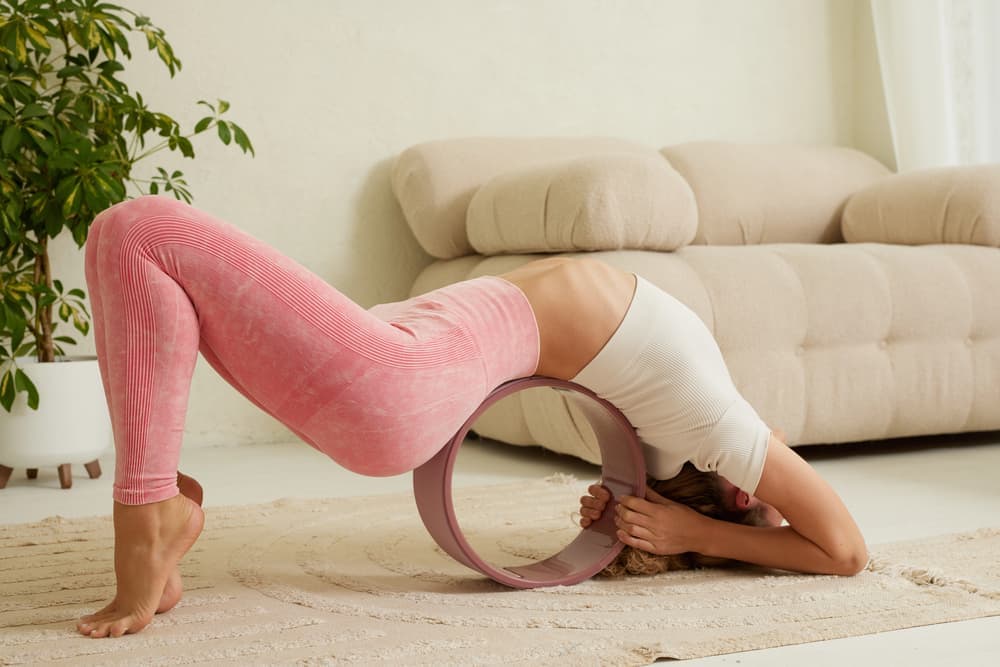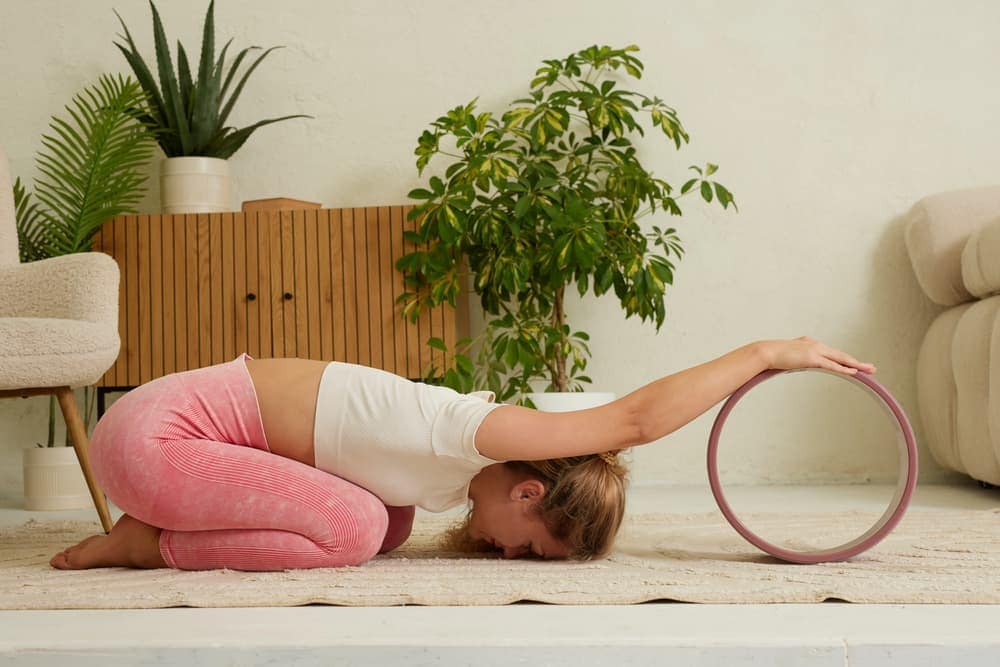A yoga wheel is a circular prop used to deepen stretches, improve flexibility, and support balance during yoga practice. It helps both beginners and advanced yogis safely explore backbends and open tight areas like the chest, shoulders, and hips.
In recent years, props like the yoga wheel have become popular as people discover how much they can enhance comfort, alignment, and confidence on the mat.
Continue reading this yoga wheel guide to discover how this accessory works and how to incorporate it into your own practice.
What Is a Yoga Wheel?
A yoga wheel is a circular prop, about 30 to 33 cm (or 12 to 13 inches) in diameter, designed to support and enhance your yoga practice.
It’s lightweight but sturdy, often built with a strong inner core and a soft, grippy outer layer to keep you comfortable as you move.
The yoga wheel serves several purposes:
- Deepen stretches and safely push your flexibility further.
- Improve balance by providing stable support.
- Release tension in tight areas of the body.
Some of the biggest benefits stem from its versatility. You can use it to:
- Open your chest and shoulders for better posture.
- Stretch the abdomen and hip flexors after long hours of sitting.
- Massage the spine by gently rolling on the wheel, which eases stiffness.
It’s a simple but powerful tool that makes yoga more accessible and rewarding.
How to Use a Yoga Wheel
A yoga wheel is a versatile tool that gives support, deeper stretches, or added challenge. Whether you’re working on flexibility, strength, or relieving tension, it can make your practice more effective and accessible.
Here are some common ways to use it.

1. Backbends and Spinal Release
A yoga wheel is one of the best tools for opening your chest, shoulders, and spine. Try these exercises:
- Supported Backbend. Sit on the floor with the wheel behind your spine. Lean back slowly and let it support your back while opening your chest.
- Hip-Lift Backbend. Start in a supported backbend and press your feet into the mat. Lift your hips and roll the wheel along your spine to release tension.
2. Deep Stretches
The yoga wheel can help you ease further into familiar yoga poses, like:
- Assisted Child’s Pose. Kneel with the wheel in front of you. Roll it forward as you fold down to stretch your arms, shoulders, and spine.
- Seated Forward Fold. Sit with your legs straight and the wheel at your feet. Use it to guide your fold and deepen your hamstring stretch.
- Lizard Lunge. Step into a low lunge with the wheel under your back ankle. Roll it back as you extend your leg for a deeper stretch.
3. Strength and Balance
Because it’s slightly unstable, the wheel makes core and balance work more intense. Here are some examples:
- Plank Pose. Place your shins on the wheel and your hands on the mat. Roll forward and back to engage your core.
- Crow Pose. Place the wheel flat and rest your feet on it as you lift into Crow. This adds more challenge and tests your balance.
- Standing Balance. Use the wheel as a prop in poses like Tree or Warrior III. Rest a foot or hand on it for extra stability and stretch.
Safety Tips When Using a Yoga Wheel
A yoga wheel can be a fantastic tool for stretching, balance, and strength, but only if used safely. The wheel moves easily, so it’s important to stay mindful and listen to your body. Here are some tips to keep your practice safe and enjoyable:
✅ Do’s
- Start with gentle stretches to warm up.
- Move slowly and with control.
- Engage your core for balance and back support.
- Use a yoga mat or a non-slip surface.
- Practice near a wall if you need extra stability.
❌ Don’ts
- Don’t use the yoga wheel on slippery floors.
- Don’t rush into deep backbends right away.
- Don’t force yourself into painful positions.
- Don’t ignore intense pain. Stop immediately.

Give the Yoga Wheel a Spin
A yoga wheel is more than just a trendy prop. It’s a simple way to stretch deeper, strengthen muscles, improve balance, and ease tension.
Start with beginner-friendly poses and build up as your confidence grows. Using it mindfully will help you get the most out of your yoga journey.
Why not grab a wheel and see what it can do for you? For a great option, check out our Lotus Wheel review.
Related Questions
1. How do I choose the right yoga wheel size?
The right yoga wheel size depends on your height, body size, flexibility, and experience. Standard wheels (12 inches) work well for most people. Mini wheels (6 inches) offer more targeted support, while larger wheels provide a deeper stretch. Our guide on how to choose the right yoga wheel size has more details.
2. Are yoga wheels suitable for beginners?
Yoga wheels are suitable for beginners when used in simple, supportive poses. They can help you stretch safely, improve flexibility, and build confidence without straining. For easy starting positions, read our guide on yoga wheel exercises for beginners.
3. Can a yoga wheel help with back pain?
A yoga wheel can help with back pain by gently massaging your spine, opening your chest, and easing tension from sitting or hunching. When used correctly, it supports safe stretches that improve flexibility and comfort. Check out our previous article to learn more about how a yoga wheel helps with back pain.
- Can Short Workouts Really Boost Daily Energy? - 28 October 2025
- How Can You Build a Balanced Plate for Every Meal? - 27 October 2025
- What Is a Yoga Wheel and How to Use It? - 29 September 2025
